The first time I went backpacking as an adult, I figured that my regular flashlight would be fine. But I ask you, Have you ever tried going to the bathroom outside in the dark while holding a flashlight in your hands?
I’ll leave the imagining of the logistics of digging a latrine, squatting, and toilet paper with one hand to you!
On that first camping trip, I was really envious of my friend who had brought a headlamp with him. He was able to walk around, find gear in his pack, and (yes) pee with ease because his hands were free.
So I decided to get myself a headlamp.
Years have passed since I bought my first headlamp (a cheap Coleman CHT 4which I still love). Since then, I’ve learned a lot about buying headlamps. Here are my tips for making sure you get a quality headlamp suited to your needs.
Tip # 1: Don’t Buy One Of Those Super-Cheap Headlamps!
The first cheap headlamps I found (both online and in stores) were only about $10-$15. They all look something like this:
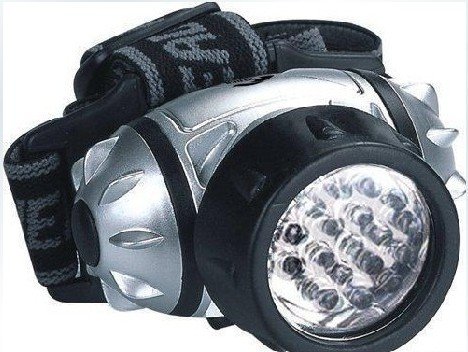
While the price tag was attractive, I know from experience that…
It doesn’t pay to buy cheap gear!
First, I’m going to let you in on a little secret. Those cheap headlamps actually come from drop shopping companies in China. They make loads of crappy products, sell them in lots of around 100 at sites like Ali Express, and then buyers resell them at a huge markup.
The cheap headlamp that you see above – it originally cost about $191 for a lot of 50. That comes out to $3.82 per headlamp!
Here are just some of the reasons you do NOT want a super cheap headlamp:
- Really Big and Bulky: With every step you take, you’ll feel that thing wobbling around on your head.
- You’ll Blow Through Batteries: The batteries run out in just 3 hours on most of those headlamps!!!
- Cheap, Crappy Plastic: It might be okay to buy a 3 dollar headlamp for having around the house in case of a power outage, but it is not something you want to rely on while camping in the wilderness.
Tip #2: Battery Life Matters
I’m an ultra-minimalist backpacker. Partly out of personal style. Partly out of necessity.
Because I have no car and go camping with my young daughter, I’ve got to carry almost all of the gear myself. I do not have extra space or strength for carrying around lots of extra batteries! The longer the batteries last, the fewer backup batteries you need to bring.
Long battery life is also a matter of safety.
What if you get lost and have to use your headlamp all night? You don’t want one which is going to die on you.
I personally wouldn’t get any headlamp with a battery run time of less than 20 hours. Some great headlamps have impressive run times. Take the Black Diamond Icon headlamp which runs for 75 hours on high mode and 175 hours on low mode!
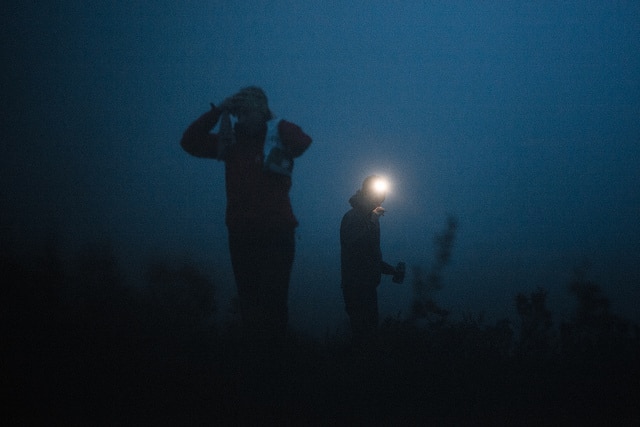
When hiking in the dark, the last thing you want is your headlamp battery to die on you!
Tip #3: Take Lumens with a Grain of Salt
A headlamp with 160 lumens! It must be better than the headlamp with 60 lumens, right?
It turns out that lumens is really misleading.
The way that lumens is measured is with a device called an integrating sphere which measures the total amount of light put out by the bulbs or LEDs. But this doesn’t necessarily tell you how concentrated or smooth the light pattern will be.
I’m not an expert on optics, but I can tell you that some of those super high-lumen headlamps don’t illuminate camp any better than my 40 lumen Coleman headlamp does!
Tip #4: Look At Beam Distance Instead
Instead of looking at the lumens of a headlamp, look at the beam distance. To do this, you’ve got to understand that there are two types of lighting modes on good headlamps:
- Floodlight: This is a dimmer, wider setting. It is good for illuminating things which will be in close proximity – like when I write in my notebook in the tent after Isabel has gone to bed. Really cheap headlamps will just have a floodlight and not a spotlight.
- Spotlight: This is a much more focused beam of light. There are some situations when having a super-long beam spotlight are helpful. Like that time I got out of the tent in the middle of the night to see what the hell is running up and down the trees? Turns out it was just squirrels having a party.
Each of these lighting modes will have its own beam distance. Just like with lumens, the beam distance rating is misleading. However, beam distance is a much better indicator of performance.
Plus, beam distance will tell you whether the headlamp is actually suited to your needs or not. The last tip will tell you why.
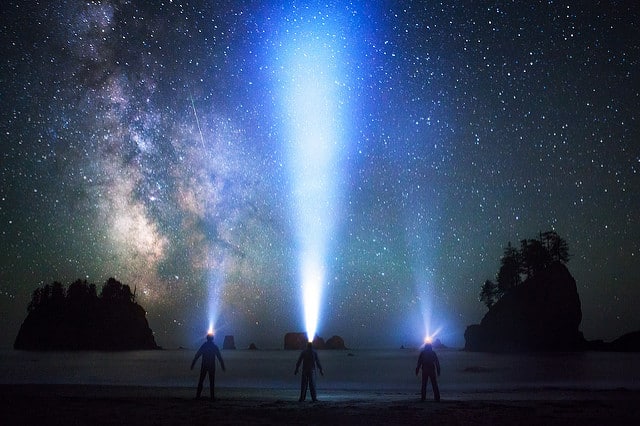
Aside from being a beautiful picture, this shows you the difference in headlamp beam lengths
Tip #5: The Red Light Setting is Awesome
My Coleman CHT4 headlamp has a red light setting. My Petzl Tikka Pro does not.
After using both of these headlamps, I can tell you that I will NEVER buy a headlamp without a red light setting again!
There are a few reasons the red light setting is so great:
- You don’t blind people when looking at them
- The battery lasts really long in this setting
- You won’t wake everyone up in the tent when you turn it on
You can also find some headlamps with green and blue lights. These can be used for signaling. Apparently hunters use the colored lights to help them identify animals. This vegan wouldn’t know anything about that though!
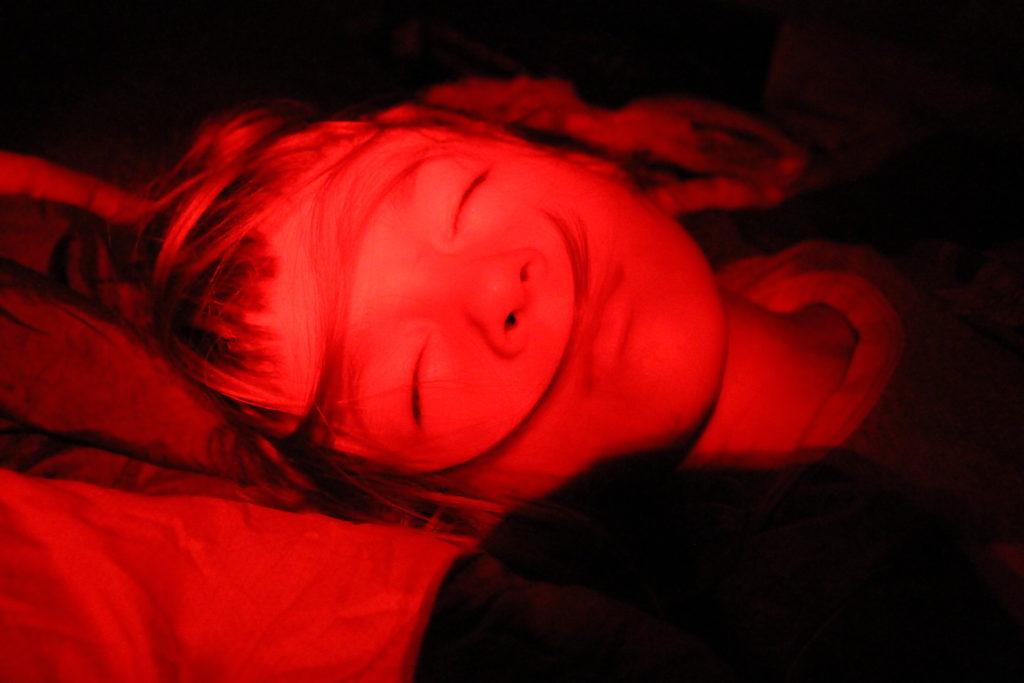
The red light setting is awesome for when you don’t want to wake people up in the tent!
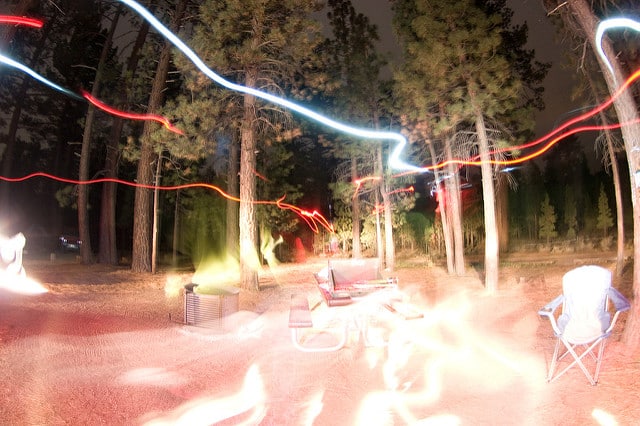
The red light setting is also awesome for playing headlamp games
Tip #6: Get the Same Type of Batteries As Your Other Gear
When shopping for a headlamp, pay attention to what type of batteries it uses. They will usually be either AA or AAA batteries.
Make sure that all of your battery-operated gear (flashlights, camera, radio, etc.) uses the same type of batteries. This way you only have to bring one type of spare battery and can swap the batteries between gear in a pinch.
*There are some headlamps with rechargeable solar batteries. I love this idea but personally have never tried any of them.
Tip #7: Getting Wet?
When it starts raining at camp, we usually just retreat to our tent to play Go Fish and watch the shadows of slugs sliming the rain fly. So, I don’t need a headlamp rated for severe water. I’m sure this is crucial for some backpackers though.
The waterproofness of headlamps is rated in IPX. You can find a detailed table of info about what each of the IPX ratings means here. And here’s an overview:
- IPX-4: Withstands longer-lasting rain storms
- IPX-7: Can withstand being submerged in water of up to 1 meter for 30 minutes.
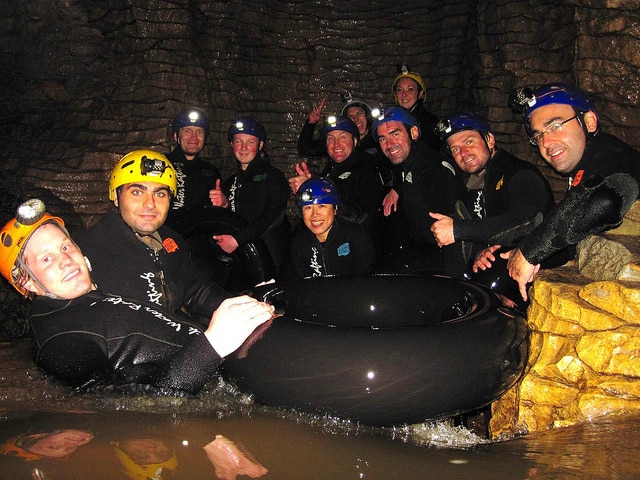
When going black water rafting inside of a cave, you need a headlamp with a high IPX rating!
Tip #8: What Do You Need to See in the WORST CASE Scenario?
My daughter and I don’t do anything too crazy. We hike to camp during the day, set up everything by nightfall, and are asleep fairly early.
So, our cheap 40 lumen, low beam Coleman headlamp is good for most cases.
But there was that time that Isabel left her stuffed zebra on the trail and we had to go on a “rescue mission” to find it. Hiking at night is not something that I would normally do (sprained ankles suck), but we had to save Zebra! I was really glad to have a headlamp with a longer beam so we could see in front of us better.
When choosing a headlamp, think about the worst case scenario you might be in.
That might be a first aid disaster which requires you to trek through the wilderness to get help.
Or it might be that you got lost and need a headlamp that can last you through the night.
Or maybe you are super clumsy and fall into rivers often – you might want to get that IPX-7 headlamp just in case!
Think about these realistic worst-case-scenarios and you’ll be able to figure out which headlamp features you really need and which ones are just a luxury.
My Favorite Headlamps for Camping and Backpacking
#1: Coleman CHT 4 Headlamp
This was my first headlamp. After 3 years and many trips, I still use it. I love it because it is super cheap, has 3 settings (high, low, red), and the lamp tilts so you don’t blind people when talking to them. The lumens is low but the light quality is great.
Features:
- Modes: High, Low, Red
- Lumens: 40 lumens high, 23 lumens low
- Beam Length: 104 feet beam
- Battery life: 20 hours on high, 35 hours on low
- Other: Red light setting, Pivoting head, 2 AA batteries
- Best For: People who want a durable, functional camping headlamp on a very small budget
- Buy Here
#2: Coast HL7 Focusing Headlamp
This headlamp lacks a red light setting, which kind of sucks if you are camping with other people and don’t want to wake them. But it makes up for this with its super-bright and long-distance beam.
Features:
- Modes: High, Low
- Lumens: 285 lumens high, 4 lumens low
- Beam Length: 390 feet high, 13 feet low
- Battery Life: 90 minutes high, 70 hours low
- Other: Pivoting head, 3 AAA batteries
- Best For: Backpackers who need to see far distances in the night, such as when night hiking.
- Buy Here
#3: Black Diamond Icon Headlamp
The Black Diamond Icon is one of the most popular headlamps because it has features for virtually every outdoor use and is priced very well (at least compared to other headlamps with similar features). The only annoying thing is that it requires 4 AA batteries, which makes it rather heavy and bulky.
Features:
- Modes: Spotlight (called “QuadPower”), Proximity (called “2x SinglePower”), Red, Strobe. PLUS the QuadPower, SinglePower and Red Light are Dimmable!
- Lumens: 200 lumens full QuadPower, 4 lumens dimmed QuadPower, 35 lumens full SinglePower, 4 lumens dimmed SinglePower
- Beam Length: 328 feet high, 115 feet low
- Battery Life: 75 hours full QuadPower, 250 hours dimmed SinglePower
- Other: IPX 7, Lock Mode prevents light from turning on in pack, Battery Indicator tells you how much battery life is left
- Best For: People who go backpacking or mountaineering regularly and are ready for a more serious headlamp.
- Buy Here
#4: Black Diamond ReVolt
Here is another headlamp by Black Diamond. What is unique about the ReVolt is that it has rechargeable batteries. You can recharge them by plugging the headlamp into your car’s cigarette lighter or with a solar charge (if you are bringing one with you). You can also use standard AAA batteries with the ReVolt. I also love that there is an indicator (as with the Black Diamond Icon) that tells you how much battery life is left.
Features:
- Modes: High (called TriplePower), Low (called SinglePower), Red, Dimmable
- Lumens: 110 lumens high with Alkaline batteries, 25 lumens low with Alkaline batteries, 4 lumens dimmed
- Beam Length: 70 meters high, 9 meters low
- Battery Length: 70 hours high, 300 hours low
- Other: IPX 4, Rechargeable NiMH batteries or standard AAA batteries, Battery life indicator
- Best For: People who are sick of worrying about replacement batteries for their headlamp
- Buy Here


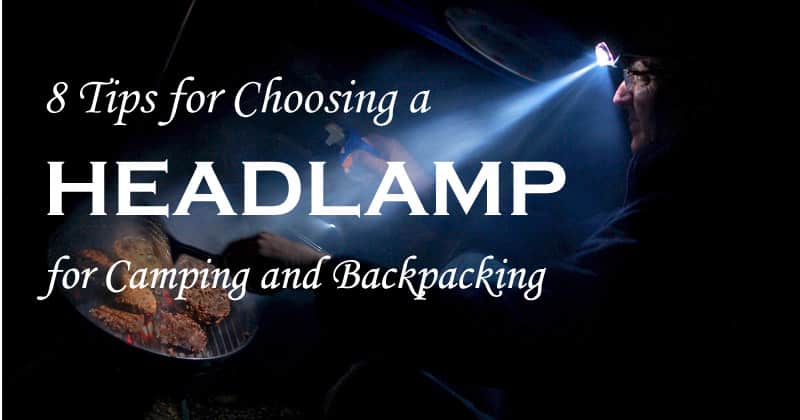
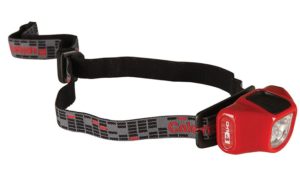
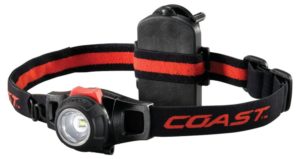
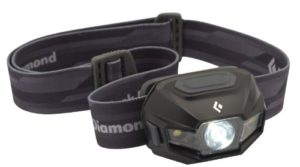










2 Comments
Michael Schneider
October 30, 2020 at 3:14 amThe green lens is good to retain night vision AND be able to see the topo map elevation lines (They wash out under red light) My favorite light is below and comes with clear, red, green, and blue lens. I set mine to come on with red so as to minimally disturb other hikers/campers. High, Low, Strobe and Off.
Princeton Tec Quad Tactical
POWER 78 Lumens
LAMP 4 Ultrabright LEDs (regulated)
BURN TIME 60.5 hours
BATTERIES 3 AAA Alkaline or Lithium
WEIGHT 3.6oz / 101g
WATER RESISTANT IPX7
WARRANTY Lifetime
Stephen Ryan
January 17, 2022 at 2:43 pmTo use the Princeton headlamp, the first click turns on the low red light, the second click turns on the high red light. There is no flashlight. You have to hold down to get the white light. You don’t have to go through a bunch of modes every time I’ve been looking for a headlamp like this for a while and I liked it so much that I bought a second one.